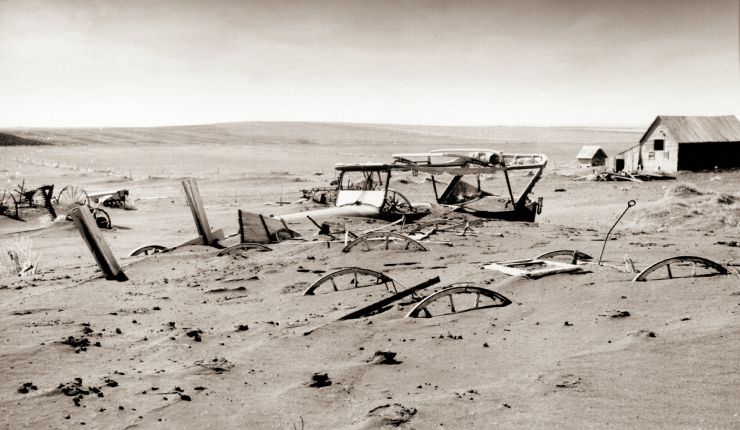Background:
Soil erosion is a major threat to soil health and agricultural productivity, with 10 million ha of cropland lost each year to erosive processes.1 Global soil loss is estimated to be occurring at 10 to 40 times the rate of formation.1 Soil erosion is driven primarily by moving water and wind, though slumps may occur due to gravity. Bare and sloping soils are particularly susceptible, particularly after disturbance by tillage or by deforestation.2-3 Soil erosion can have significant negative impacts on soil fertility, decreasing crop yields through nutrient loss. Additionally, erosion can have negative impacts on human health; water driven erosion can increase pathogen and pollutant loads into surrounding waterways while wind driven soil erosion can increase the incidence of respiratory disease.4-5 However, manageable factors such as field length, surface roughness, and slope and orientation all play a significant role in decreasing soil loss due to wind and water erosion.2, 6 Conservation agriculture practices such as line leveling fields, contour ridging, adding swales, and reducing tillage may reduce wind driven erosion by more than 75% and water driven erosion by 98%.3, 7-9

Wind Erosion-NRCS
https://www.flickr.com/photos/exit78/29081984692

Dust from Wind Erosion-NRCS
https://www.flickr.com/photos/exit78/29110171361/in/photostream/
Diagnosis:
Water Erosion
- Sheet erosion is enabled by the suspension of soil particles in runoff water dislodged by the impact of raindrops. Identifying soil loss by sheet erosion can be challenging due to the uniform loss of soil from the soil surface; changes in top soil color, down-slope accumulation of soil, and reduced yields are diagnostic.2, 10
- Rill Erosion is evidenced by soil loss along long narrow channels where water flows preferentially. Rills may be tilled over and their location in a field may change yearly depending on in field water movement which may be used to diagnose problem areas.2, 10
- Gully Erosion is very visually obvious. Larger than rills and often many meters wide and deep, gullies are disruptive to the infield movement of farmers and farm equipment.2, 10

Rill Erosion-UCANR
http://ucanr.edu/blogs/FoothillAg//blogfiles/35162_original.jpg Lynn Wunderlich
Wind Erosion
- Wind Erosion may be challenging to identify due to the uniform loss of soil from the soil surface. Methods for identification include changes in top soil color, reduced yields, and the accumulation of soil along fence lines or permanently vegetated areas.3
Management:
Leveling Fields/Limiting field length
These practices work to slow overland waterflow, limiting the mass of soil that water may carry as it moves.2, 10
- Farming on the contour may may help inhibit water driven soil erosion.
- Contour ridging is a particular practice which can help minimize soil erosion.
- Fencing can slow and catch sediments and eolian dust.
Increasing Vegetative Cover
These practices reduce soil loss by intercepting rain droplets before they hit the soil surface, reducing wind speed at the soil surface, and reducing the speed with which water can flow along the soil surface.2-3, 10
- Using Buffer strips can break up fields to reduce wind and water speed.
- Crop residues, cover cropping, and minimizing tillage may all inhibit the erosive loss of soil by wind and water.
- Permanent vegetation may be used to inhibit soil erosion.
Increasing Surface Roughness:
These practices work by reducing wind speed and water flow over the land, increasing infiltration and preventing soil particle creep and saltatation.
- Terracing, Tracking/Grooving,Strip Ripping/Contour Plowing are physical methods for reducing erosive soil loss.
Additional Resources:
Leveling Fields
- A review of soil and water conservation measures and challenges in Kenya developed by the University of Nairobi http://www.lupinepublishers.com/ciacr/pdf/CIACR.MS.ID.000148.pdf.
- Resource on various soil issues and soil management developed by the Department of Primary Industries and Regional Development of the Western Australian government. https://www.agric.wa.gov.au/climate-land-water/soils/managing-soils
- A soil conservation handbook developed by the Ministry for the Environment of New Zealand. https://www.mfe.govt.nz/sites/default/files/soil-conserv-handbook-jun01.pdf.
- A handbook developed by the Kenyan Ministry of Agriculture for the prevention of soil erosion through soil conservation strategies. https://library.wur.nl/isric/fulltext/isricu_i6377_001.pdf.
- A chapter on the physics of wind erosion and its control developed by the USDA. https://infosys.ars.usda.gov/WindErosion/publications/Andrew_pdf/795.pdf.
- A fact sheet on wind erosion developed by the National Landcare Program of the Australian Government. http://www.naturalresources.sa.gov.au/files/sharedassets/south_east/sustainablag/land/fact_sheets/wind_erosion_management.pdf.
Further Information
- A soil conservation guide developed by the World Agroforestry Center with a focus on improving land management in eastern and southern Africa. http://www.worldagroforestry.org/downloads/Publications/PDFS/wp06113.pdf.
- A guide developed by Kansas State University on the principles of wind erosion and its control. https://www.ars.usda.gov/ARSUserFiles/30200525/419PrinciplesofWinderosionanditscontrol.pdf
- A factsheet website about soil erosion developed by the Ontario Ministry of Agriculture, Food, and Rural Affairs. http://www.omafra.gov.on.ca/english/engineer/facts/12-053.htm.
References:
- Pimentel, D.; Burgess, M., Soil erosion threatens food production. Agriculture 2013, 3 (3), 443-463.
- Hicks, D. H.; Anthony, T., Soil conservation technical handbook. United Book Prints: 2015.
- Presley, D.; Tatarko, J. L., Principles of wind erosion and its control. 2009.
- Li, C.; Bair, D. A.; Parikh, S. J., Estimating potential dust emissions from biochar amended soils under simulated tillage. Sci. Total Environ. 2018, 625, 1093-1101.
- Tyrrel, S.; Quinton, J. N., Overland flow transport of pathogens from agricultural land receiving faecal wastes. Journal of Applied Microbiology 2003, 94, 87-93.
- Renard, K. G.; Foster, G. R.; Weesies, G.; McCool, D.; Yoder, D., Predicting soil erosion by water: a guide to conservation planning with the Revised Universal Soil Loss Equation (RUSLE). United States Department of Agriculture Washington, DC: 1997; Vol. 703.
- Seta, A.; Blevins, R.; Frye, W.; Barfield, B., Reducing soil erosion and agricultural chemical losses with conservation tillage. Journal of Environmental Quality 1993, 22 (4), 661-665.
- Baker, J. B.; Southard, R. J.; Mitchell, J. P., Agricultural Dust Production in Standard and Conservation Tillage Systems in the San Joaquin Valley. Journal of Environmental Quality 2005, 34, 1260-1269.
- Montgomery, D. R., Soil erosion and agricultural sustainability. Proceedings of the National Academy of Sciences 2007, 104 (33), 13268-13272.
- Ritter, J. Soil Erosion-Causes and Effects. http://www.omafra.gov.on.ca/english/engineer/facts/12-053.htm (accessed 8/27).
